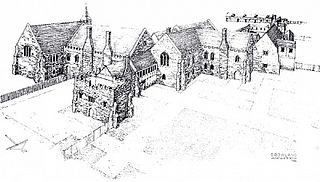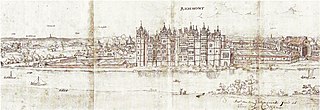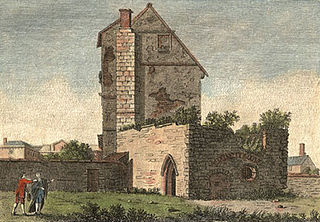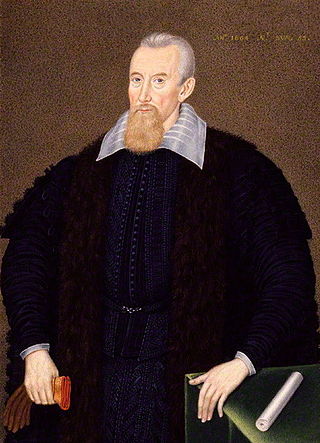
Duke of Marlborough is a title in the Peerage of England. It was created by Queen Anne in 1702 for John Churchill, 1st Earl of Marlborough (1650–1722), the noted military leader. In historical texts, unqualified use of the title typically refers to the 1st Duke. The name of the dukedom refers to Marlborough in Wiltshire.

Rosamund Clifford, often called "The Fair Rosamund" or "Rose of the World", was a medieval English noblewoman and mistress of Henry II, King of England, who became famous in English folklore.

Blenheim Palace is a country house in Woodstock, Oxfordshire, England. It is the seat of the Dukes of Marlborough and the only non-royal, non-episcopal country house in England to hold the title of palace. The palace, one of England's largest houses, was built between 1705 and 1722, and designated a UNESCO World Heritage Site in 1987.

Prince Augustus Frederick, Duke of Sussex, was the sixth son and ninth child of King George III and his queen consort, Charlotte of Mecklenburg-Strelitz. He was the only surviving son of George III who did not pursue an army or navy career. A Whig, he was known for his liberal views, which included reform of Parliament, abolition of the slave trade, Catholic Emancipation, and the removal of existing civil restrictions on Jews and Dissenters.

St James's Palace is the most senior royal palace in London, the capital of the United Kingdom. The palace gives its name to the Court of St James's, which is the monarch's royal court, and is located in the City of Westminster in London. Although no longer the principal residence of the monarch, it is the ceremonial meeting place of the Accession Council, the office of the Marshal of the Diplomatic Corps, and the London residence of several members of the royal family.

Woodstock is a market town and civil parish, 8 miles (13 km) north-west of Oxford in West Oxfordshire in the county of Oxfordshire, England. The 2011 Census recorded a parish population of 3,100.

Dunfermline Palace is a ruined former Scottish royal palace and important tourist attraction in Dunfermline, Fife, Scotland. It is currently, along with other buildings of the adjacent Dunfermline Abbey, under the care of Historic Environment Scotland as a scheduled monument.

Havering Palace was an old royal residence in England, in the village of Havering-atte-Bower. It was built before 1066 but abandoned in 1686. By 1816 no walls remained above ground.

Richmond Palace was a Tudor royal residence on the River Thames in England which stood in the sixteenth and seventeenth centuries. Situated in what was then rural Surrey, it lay upstream and on the opposite bank from the Palace of Westminster, which was located nine miles (14 km) to the north-east. It was erected in about 1501 by Henry VII of England, formerly known as the Earl of Richmond, in honour of which the manor of Sheen had recently been renamed "Richmond". Richmond Palace therefore replaced Shene Palace, the latter palace being itself built on the site of an earlier manor house which had been appropriated by Edward I in 1299 and which was subsequently used by his next three direct descendants before it fell into disrepair.

Oatlands Palace is a former Tudor and Stuart royal palace which took the place of the former manor of the village of Oatlands near Weybridge, Surrey. Little remains of the original building, so excavations of the palace took place in 1964 to rediscover its extent.

Beaumont Palace, built outside the north gate of Oxford, was intended by Henry I about 1130 to serve as a royal palace conveniently close to the royal hunting-lodge at Woodstock. Its former presence is recorded in Beaumont Street, Oxford. Set into a pillar on the north side of the street, near Walton Street, is a stone with the inscription: "Near to this site stood the King's Houses later known as Beaumont Palace. King Richard I was born here in 1157 and King John in 1166". The "King's House" was the range of the palace that contained the king's lodgings.

Theobalds House in the parish of Cheshunt in the English county of Hertfordshire, north of London, was a significant stately home and (later) royal palace of the 16th and early 17th centuries.

Windsor Castle is a royal residence at Windsor in the English county of Berkshire. It is strongly associated with the English and succeeding British royal family, and embodies almost a millennium of architectural history.
William Fowler was a Scottish poet or makar, writer, courtier and translator.

Edward Bruce, 1st Lord Kinloss PC was a Scottish lawyer and judge.

Glympton is a village and civil parish on the River Glyme about 3 miles (5 km) north of Woodstock, Oxfordshire. The 2001 Census recorded the parish's population as 80. The village and church are owned by the Glympton Park estate.

The Palace of Holyroodhouse, commonly referred to as Holyrood Palace or Holyroodhouse, is the official residence of the British monarch in Scotland. Located at the bottom of the Royal Mile in Edinburgh, at the opposite end to Edinburgh Castle, Holyroodhouse has served as the principal royal residence in Scotland since the 16th century, and is a setting for state occasions and official entertaining.

Kings Langley Palace was a 13th-century Royal Palace which was located to the west of the Hertfordshire village of Kings Langley in England. During the Middle Ages, the palace served as a residence of the Plantagenet kings of England. It fell into disuse sometime during the 16th century and became a ruin. Today, nothing remains of the building except for some archaeological remains. The site is a scheduled ancient monument.
Sir Edward Zouch of Woking was a courtier to English kings James and Charles I, a masque actor, and Knight Marshal of the King's Household.
Mary Middlemore was a Courtier and Maid of Honour to Anne of Denmark, subject of poems, and treasure hunter.


















